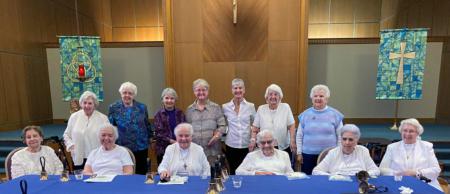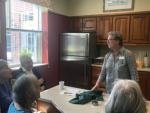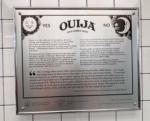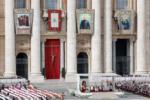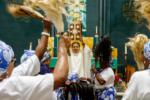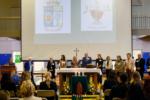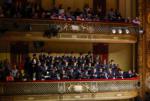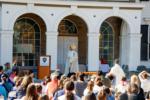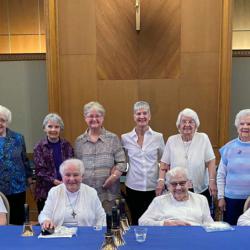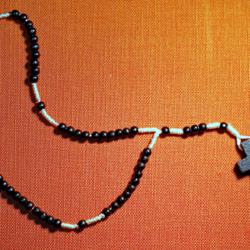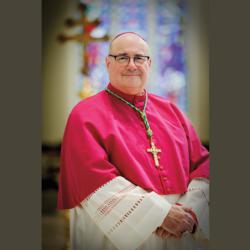Contemplating the mysteries of the Sacred Heart of Jesus
(OSV News) -- When the beloved disciple reclined his head upon the breast of the Savior (cf. Jn 13:25), he heard the beats of divine charity and felt the heat of God's love. Among the Twelve Apostles, it was John alone who stood beside the Blessed Mother at the foot of the cross to witness and absorb the pain of Jesus' Passion (cf. Jn 19:25-27). It was the same John who would later testify, quite simply, that "God is love" (1 Jn 4:8).
This beloved disciple contemplated the mysteries of the Sacred Heart of Jesus. While many after him who loved Christ pondered and revered this blessed heart, it wasn't until 16 centuries later that devotion to the Sacred Heart passed from a private to a public devotion in the church. That is when the Lord revealed the wonders of his heart to a young and often sickly religious sister named Margaret Mary Alacoque.
St. Margaret Mary Alacoque (1647–1690) was a nun of the Order of the Visitation of Holy Mary in the French village of Paray-le-Monial. Before Margaret Mary, a devotion to the Sacred Heart developed from an earlier devotion to Christ's holy wounds. Devotees of the Sacred Heart included such saints as Bernard of Clairvaux (d. 1153), Bonaventure (d. 1274), Mechtilde of Helfta (d. 1298) and Gertrude the Great (d. 1302).
What was different with Margaret Mary is that through three divine revelations she received, the Lord commissioned her to open this devotion to the entire church.
-- The first revelation: Becoming the beloved
On Dec. 27, 1673, on the feast of John the Apostle, Sister Margaret Mary received the first of three revelations of the Lord's Sacred Heart. Her religious superior ordered her to write an account of her experience, which begins:
"Once being before the Blessed Sacrament, I felt wholly filled with this Divine Presence, and so powerfully moved by it that I forgot myself and the place which I was. … (I) yielded my heart to the power of His love (and) He made me rest for a long time on His divine breast, where He uncovered to me the wonders of His love and the inexplicable secrets of His Sacred Heart, which He had hitherto kept hidden from me (but) now He opened to me for the first time."
Jesus placed Margaret Mary into the position of the beloved disciple, reclining her head as John once did upon the breast of the Savior. Reposed and attentive, she both felt and heard what was in the Sacred Heart. This is the message of Jesus to her in the first revelation: "My Divine Heart is so passionately in love with men that it can no longer contain within itself the flames of its ardent charity. It must pour them out by thy means, and manifest itself to them to enrich them with its precious treasures, which contain all the graces of which they have need to be saved from perdition. I have chosen thee as an abyss of unworthiness and ignorance to accomplish so great a design, so that all may be done by Me."
By this first revelation, the Lord makes known that divine love can no longer be hidden in the heart of Jesus. Here, Jesus is the friend, the love of the Father, who makes the tender effort to save his children. It is precisely Margaret Mary's "unworthiness and ignorance" that will serve this good end, for her humbleness will not obscure the unsolicited graciousness of Christ's charity.
When Margaret Mary offered her own heart to Jesus, he responded by sharing a spark of his ardent divine love with her. The fervor of that love remained with her in the form of an invisible wound in her side, in which thereafter, on the first Friday of each month, she experienced intense heat and pain. In prayer and in passion, Margaret Mary remained a student of the secrets of the Lord's heart for six months before a second revelation.
-- Second revelation: The scourge of ingratitude
In the summer of 1674, likely on the first Friday in June during the octave of Corpus Christi, Margaret Mary received the Lord's second revelation. Jesus' appearance was now different from the first. In the words of the saint: "He was brilliant with glory; His five wounds shone like five suns. Flames darted forth from all parts of His sacred humanity, but especially from His adorable breast, which resembled a furnace, and which, opening, displayed to me His loving and amiable Heart, the living source of these flames."
In adoration, Margaret Mary gazed upon the wonders of Christ's pure love, which shines in inestimable excess against the ingratitude of those for whom it is given. By direct address, the Lord declared the severity of the world's ingratitude for his sacrifice: "This is much more painful to Me than all I suffered in My Passion. If men rendered Me some return of love, I should esteem little all I have done for them, and should wish, if such could be, to suffer it over again; but they meet My eager love with coldness and rebuffs. Do you, at least, console and rejoice Me, by supplying as much as you can for their ingratitude."
The character of the renewed devotion to the Sacred Heart is hereby disclosed: It is a means for making amends for the world's crimes of callousness, offered as consolation for Jesus' aching heart. To adore the Sacred Heart is to participate in making reparations for the scandal of ingratitude.
The devotion that the Lord calls for begins to take definite shape in this revelation as he directs Margaret Mary to two distinct disciplines: First, to receive holy Communion every first Friday of the month, and second, to keep a Holy Hour, preferably before the Blessed Sacrament, between 11 p.m. and midnight every Thursday, so as to keep watch with him as expiation for the desertion of the disciples during his agony in Gethsemane.
As Margaret Mary herself heeded this devotion and drew nearer to the Lord's love in his passion, she also began to experience her own share in his suffering, as religious authorities doubted her and caused her to doubt her own experiences of Christ's grace. It was not until a young Jesuit priest received her testimony and counseled her that she was assured of the veracity of Christ's message to her. This young priest, Father Claude La Colombière, would later become the man to bring the devotion of the Sacred Heart to the world.
-- Third revelation: For the life of the church
The third and final revelation to St. Margaret Mary occurred on June 16, 1675, during the Octave of the Feast of the Blessed Sacrament. With this revelation, the Lord moved from granting Margaret Mary personal favors to investing her in a public mission for the good of the church.
Revealing his heart again to the saint, the Lord offered these words: "Behold this Heart which has so loved men that it has spared nothing, even to exhausting and consuming itself, in order to testify its love. In return, I receive from the greater part only ingratitude, by their irreverence and sacrilege, and by the coldness and contempt they have for Me in this sacrament of love. … It is for this reason I ask thee that the first Friday after the Octave of the Blessed Sacrament be appropriated to a special feast, to honor My Heart by communicating on that day, and making reparation for the indignity that it has received. And I promise that My Heart shall dilate to pour out abundantly the influences of its love on all that will render it this honor or procure its being rendered."
The ultimate end of this devotion is, thus, to warm the church with Christ's divine love. Through this young religious sister -- meek and humble of heart -- the Lord sought to drive out what is old and stale in the church with the fire of love pouring forth from his own heart.
Sister Margaret Mary entrusted this revelation to Father Colombière. After careful consideration, he confirmed for her the divine inspiration of this grace, which led the nun to lie prostrate in joy and consecrate herself to the Sacred Heart. Father Colombière joined her in this act of consecration so that, in these two -- a religious sister and a priest -- the first fruits of the new devotion ripened.
From this first act of devotion, the threefold practice of devotion to the Sacred Heart began to emerge in the church through Father Colombière's dissemination: receiving Communion on the first Friday of the month, keeping a Holy Hour of adoration to watch with Christ, and the institution of the feast of the Sacred Heart.
- - - Leonard J. DeLorenzo, Ph.D., is Professor of the Practice in the McGrath Institute for Church Life at the University of Notre Dame, where he directs the Sullivan Family Saints Initiative and the Inklings Project, and hosts the podcast "Church Life Today."
